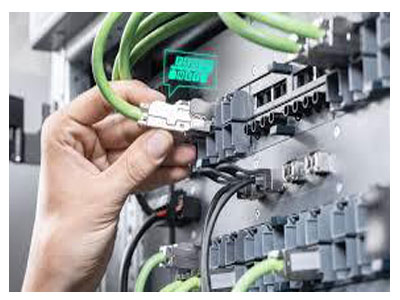Key Takeaway
Yes, PROFINET uses IP (Internet Protocol) for communication. It is built on standard Ethernet and leverages IP to transmit data across devices like PLCs, sensors, and actuators. This allows PROFINET to integrate seamlessly into industrial Ethernet networks while ensuring real-time communication.
By using IP, PROFINET supports easy device configuration, diagnostics, and remote access. It combines the speed and reliability of Ethernet with the flexibility of IP, making it ideal for complex automation systems. This compatibility also enables PROFINET to coexist with other Ethernet-based protocols in the same network.
Understanding How PROFINET Leverages IP for Data Communication
PROFINET is an Ethernet-based protocol, which means it relies heavily on IP to facilitate data exchange. IP, the same protocol that powers the internet, allows PROFINET to manage communication between various devices like PLCs, sensors, and actuators.
Here’s how it works:
1. Data Transmission: IP breaks data into packets and ensures they are delivered to the correct destination.
2. Addressing and Routing: Each device in a PROFINET network has an IP address, making it easy to identify and route messages accurately.
3. Scalability: IP enables PROFINET to support networks ranging from small setups to complex factory systems.
The reliance on IP ensures that PROFINET can deliver real-time communication, a critical requirement in industrial automation. By leveraging this technology, PROFINET provides the speed and reliability needed for modern automation processes.

Key Features of IP-Based Communication in PROFINET Networks
IP-based communication is at the heart of PROFINET’s efficiency and reliability. It brings several unique features that make it ideal for industrial applications:
1. Real-Time Data Exchange: IP supports real-time communication, enabling devices to transmit and receive data within milliseconds. This is essential for applications like robotics and motion control.
2. Global Standards: As IP is a universal protocol, PROFINET can integrate seamlessly with IT systems and other Ethernet-based networks.
3. Flexible Addressing: IP allows devices to be dynamically assigned addresses, making network configuration easier and reducing manual effort.
4. Diagnostics and Monitoring: IP-based systems provide robust diagnostics, helping engineers quickly identify and resolve issues in the network.
5. Secure Communication: PROFINET uses IP to implement advanced security measures, protecting industrial networks from cyber threats.
For example, in a packaging line, IP ensures that each device—from conveyor belts to labeling machines—communicates accurately and promptly, maintaining smooth operations.
Performance Benefits of IP in PROFINET for Industrial Automation
Performance Benefits of IP in PROFINET for Industrial Automation
How IP Enables Seamless Communication Between Devices in PROFINET
The seamless communication between devices in PROFINET networks is largely due to IP. Here’s why it works so well:
1. Standardized Protocol: IP is a well-established protocol, making it easy for devices to “speak the same language” regardless of their manufacturer.
2. Deterministic Communication: While standard Ethernet isn’t inherently real-time, PROFINET combines IP with specialized technologies like real-time (RT) and isochronous real-time (IRT) communication to ensure deterministic performance.
3. Device Addressing: Every device in a PROFINET network is assigned a unique IP address, enabling precise data exchange.
4. Multicast Communication: IP supports multicast, allowing PROFINET devices to send data to multiple recipients simultaneously. This is particularly useful for applications like process monitoring.
5. Error Detection and Correction: IP includes mechanisms for error detection and retransmission, ensuring reliable communication even in challenging industrial environments.
Imagine a bottling plant where multiple machines need to coordinate filling, capping, and labeling. IP enables these devices to communicate without delay, ensuring a consistent and efficient workflow.
Integrating IP-Based PROFINETWith Existing Industrial Networks
One of PROFINET’s strengths is its ability to integrate with existing industrial networks, even those using older protocols like PROFIBUS. Here’s how this integration works:
1. Gateways and Adapters: Devices like PROFIBUS-to-PROFINET gateways allow seamless communication between old and new systems, reducing the need for costly upgrades.
2. Hybrid Networks: PROFINET networks can coexist with legacy systems, enabling a gradual transition to modern automation.
3. Unified Communication: IP allows PROFINET to bridge the gap between IT and OT (Operational Technology) networks, creating a unified communication platform.
4. Protocol Conversion: PROFINET can convert data from older protocols into IP-compatible formats, ensuring compatibility and preserving existing investments.
5. Ease of Expansion: Adding new devices to a PROFINET network is straightforward, thanks to IP’s flexible addressing and configuration capabilities.
For example, a factory transitioning from PROFIBUS to PROFINET can use gateways to connect older devices to the new network. This allows the plant to take advantage of PROFINET’s speed and flexibility while maintaining compatibility with existing equipment.
Conclusion
The combination of PROFINET and IP is a game-changer for industrial automation. By leveraging IP, PROFINET provides the speed, reliability, and scalability required for modern production environments.
For new engineers, understanding how PROFINET utilizes IP is crucial. It bridges the gap between traditional automation systems and the demands of Industry 4.0, enabling seamless communication, real-time performance, and effortless integration with existing networks.
As industries continue to evolve, PROFINET’s IP-based approach ensures that automation systems remain efficient, flexible, and future-ready. For any industrial setup, this combination is a recipe for success.
